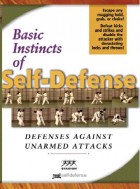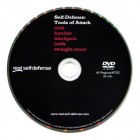The most effective methods of knocking out or incapacitating enemies
This tip is my comment on an article on knockouts in violent encounters, written by James LaFond and published in Black Belt magazine.
First, two lists of various methods of knocking out or otherwise incapacitating an opponent, based on James LaFond’s analysis of 1,675 acts of violence. The lists are arranged in order of effectiveness.
Empty hands:
100-percent success with a sucker punch by a competition-level boxer, delivered to the jaw of an individual male who is usually taller and talking.
98-percent success with a surprise come-from-behind strike executed with a heavy blunt weapon to the head of an intoxicated male.
95-percent success with a poor-leverage throw effected by a larger male against a smaller member of an aggressive group or against an individual participant in a match fight.
90-percent success with a punch thrown by an average-size athletic man against an unprepared member of a poorly organized aggressive group.
90-percent success with a kick thrown by a competition-level kickboxer against an unprepared person.
80-percent success with an elbow strike to the head or face executed by a male wrestler, boxer or kickboxer.
Weapons:
Board/club: 70%
Prison-made shank: 64%
Bat: 58%
Stone/brick/trophy: 56%
Sap/blackjack: 47%
Pointed tool: 44%
Blunt tool: 42%
Machinery/furniture: 42%
Fixed-blade knife: 38%
Stick/baton: 37% (for law-enforcement officers), 28% (for untrained persons), 27% (for groups)
Pipe/bar: 36%
Sword: 33%
Everyday item (bottle, etc.): 20% (used by the defender), 7% (used by the aggressor)
Folding knife: 19%
Pencil: 13%
Razor: 5%
Now, my comment:
In the above examples of empty-hand methods, the majority of the most reliable tactics could be called “ambushes.” (Surprising an attacker by an intended victim’s well-prepared defense looks to me a lot like an ambush.) In another tip I wrote more about ambushes.
Shank — the lowest-tech edged weapon — has the highest incapacitation rate of all listed edged weapons. This is because it is wielded by resolute fighters in a no-nonsense manner, typically ambushing their target. This shows that weapon’s effectiveness depends not so much on the nature of the weapon as on the fighter’s determination and the soundness of the weapon’s use.
Self-defense tip from Thomas Kurz, co-author of Basic Instincts of Self-Defense and author of Science of Sports Training, Stretching Scientifically, and Flexibility Express.
Self-Defense Moves
For your defense moves to work under stress they must be based on your natural, instinctive reactions, require little strength and limited range of motion, and be proven in fighting experience.To learn how your natural reactions can instantly defeat any unarmed attack, see the video Basic Instincts of Self-Defense.
Defend Against Weapons
To defend against weapons you have to know how they are used. Also — every stick has two ends … the weapon of attack may become a weapon of defense in your hand …To learn how the typical street weapons (club, knife, razor) are used by an experienced streetfighter and how to practice with them, see the video Self-Defense: Tools of Attack — Club, Hatchet, Blackjack, Knife, Straight Razor.
Mental Toughness
Staying cool under pressure is more important for self-defense than being physically fit and technically skilled. If you can’t control your mind what can you control?To learn mental techniques that let you calmly face any threat and act rationally in the heat of a fight, click here.
For a complete list of our products, click here.








I like that you pointed out that you can do a great sucker punch to someone even if they are taller than you. That is great for me to know because I am a super short woman. It might be smart for me to learn how to do a good sucker punch.